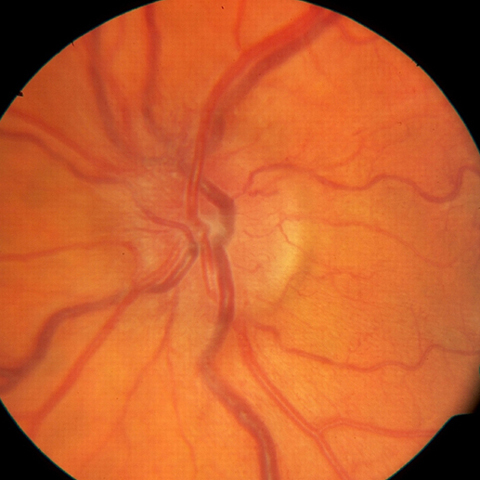Spontaneous resolution of ophthalmologic symptoms following bilateral traumatic carotid cavernous fistulae
Main Article Content
Abstract
A 38-year-old woman developed bilateral carotid cavernous fistulae (CCF) following a motor vehicle collision. Her initial ophthalmologic findings included periorbital edema, palsies of the left oculomotor and abducens nerves, and residual dilated pupils. She subsequently developed significant optic disc edema and retinal vascular dilation bilaterally. Patients with similar injuries typically require neurosurgical or vascular intervention. In this case, the patient’s signs resolved spontaneously by 21 months after onset, leaving no residual ocular deficits.
Downloads
Article Details

This work is licensed under a Creative Commons Attribution-NonCommercial-NoDerivatives 4.0 International License.
References
Mateos E, Arruabarrena C, Veiga C, et al. Massive exophthalmos after traumatic carotid-cavernous fistula embolization. Orbit 2007;26:121-4.
Fang C. Endovascular treatment of a high-flow direct traumatic carotid cavernous fistula with a two year follow-up. Interv Neuroradiol 2008;14:297-301.
Phadke RV, Kumar S, Sawlani V, et al. Traumatic carotid cavernous fistula: anatomical variations and their treatment by detachable balloons. Australas Radiol 1998;42:1-5.
Keilani ZM, Berne JD. Bilateral internal carotid and vertebral artery dissection after a horse-riding injury. J Vasc Surg 2010;52:1052-7.
Yong RL, Heran NS. Traumatica carotid cavernous fistula with bilateral carotid artery and vertebral artery dissections. Acta Neurochir (Wien) 2005;147:1109-13.
Fukuda I, Meguro K, Matsusita S, et al. Traumatic disruption of bilateral vertebral arteries and internal carotid arteries: a case report. J Trauma 1989;29:263-6.
Bilyk JR. Embryoogy and anatomy of the orbit and lacrimal system. In: Tasman W, Jaeger EA, eds. Duane’s Foundations of Clinical Ophthalmology. 2013e. Philadelphia, PA: Lippincott Williams & Wilkins; 2013.
Ikeda K, Deguchi K, Tsukaguchi M, et al. Absence of orbito-ocular signs in a dural carotid-cavernous sinus fistula with a prominent anterior venous drainage. J Neurol Sci 2005;236:81-4.
Leonard TJ, Moseley IF, Sanders MD. Ophthalmoplegia in carotid cavernous sinus fistula. Br J Ophthalmol 1984;68:128-34.
Acierno MD, Trobe JD, Cornblath WT, Gebarski SS. Painful oculomotor palsy caused by posterior-draining dural carotid cavernous fistulas. Arch Ophthalmol 1995;113:1045-9.
Miyachi S, Negoro M, Handa T, Sugita K. Dural carotid cavernous sinus fistula presenting as isolated oculomotor nerve palsy. Surg Neurol 1993;39:105-9.
Fattahi T, Brandt T, Jenkins W, Steinberg B. Traumatic carotidcavernous fistula: pathophysiology and treatment. J Craniofac Surg 2003;14:240-6.
Keizer R. Carotid-cavernous and orbital arteriovenous fistulas: ocular features, diagnostic and hemodynamic considerations in relation to visual impairment and morbidity. Orbit 2003;22:121-42.
Gupta N, Kikkawa D, Levi L, Weinreb R. Severe vision loss and neovascular glaucoma complicating superior ophthalmic vein approach to carotid-cavernous sinus fistula. Am J Ophthalmol 1997;124:853-5.
Jonas JB, Berenhstein E, Holbach L. Anatomic relationship between lamina cribrosa, intraocular space, and cerebrospinal fluid space. Invest Ophthalmol Vis Sci 2003;44:5189-95.
Kupersmith MJ, Berenstein A, Flamm E, Ransohoff J. Neuroophthalmologic abnormalities and intravascular therapy of traumatic carotid cavernous fistulas. Ophthalmology 1986;93:906-12.
Preechawat P, Narmkerd P, Jiarakongmun P, et al. Dural carotid cavernous sinus fistula: ocular characteristics, endovascular management and clinical outcome. J Med Assoc Thai 2008;91:852-8.
Leibovitch I, Modjtahedi S, Duckwiler GR, Goldberg RA. Lessons learned from difficult or unsuccessful cannulations of the superior ophthalmic vein in the treatment of cavernous sinus dural fistulas. Ophthalmology 2006;113:1220-6.
Gralla J, Schroth G, Kickuth R, et al. Closing the gap between coil and balloon in the neurointerventional armamentarium: Initial clinical experience with a nitinol vascular occlusion plug. Neuroradiol 2008;50:709-14.
Goldberg RA, Goldley SH, Duckwiler G, Vinuela F. Management of cavernous sinus-dural fistulas. Arch Ophthalmol 1996;114:707-14.
Bhatti MT, Peters KR. A red eye and then a really red eye. Surv Ophthalmol 2003;2:225-9.




